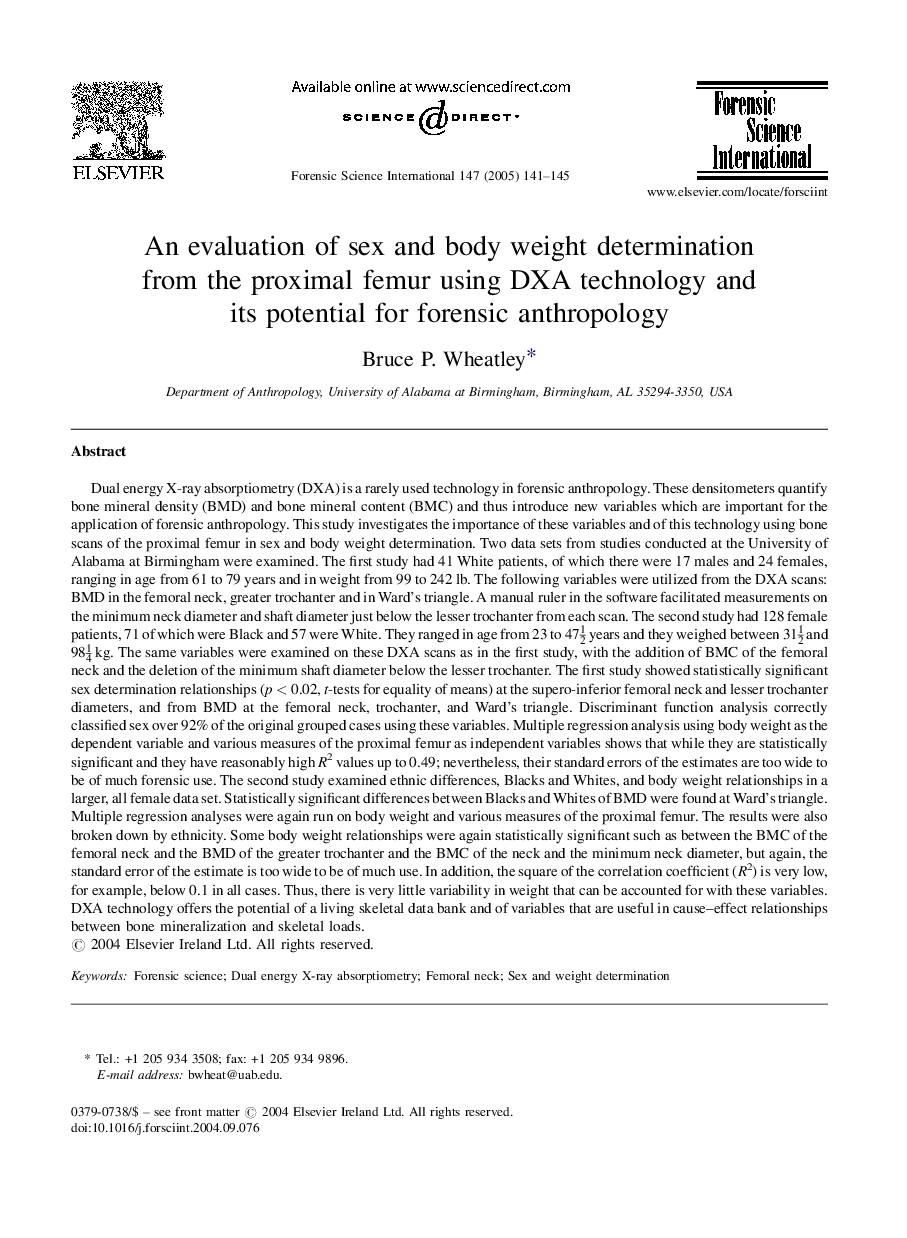| کد مقاله | کد نشریه | سال انتشار | مقاله انگلیسی | نسخه تمام متن |
|---|---|---|---|---|
| 9622638 | 160554 | 2005 | 5 صفحه PDF | دانلود رایگان |
عنوان انگلیسی مقاله ISI
An evaluation of sex and body weight determination from the proximal femur using DXA technology and its potential for forensic anthropology
دانلود مقاله + سفارش ترجمه
دانلود مقاله ISI انگلیسی
رایگان برای ایرانیان
کلمات کلیدی
موضوعات مرتبط
مهندسی و علوم پایه
شیمی
شیمی آنالیزی یا شیمی تجزیه
پیش نمایش صفحه اول مقاله

چکیده انگلیسی
Dual energy X-ray absorptiometry (DXA) is a rarely used technology in forensic anthropology. These densitometers quantify bone mineral density (BMD) and bone mineral content (BMC) and thus introduce new variables which are important for the application of forensic anthropology. This study investigates the importance of these variables and of this technology using bone scans of the proximal femur in sex and body weight determination. Two data sets from studies conducted at the University of Alabama at Birmingham were examined. The first study had 41 White patients, of which there were 17 males and 24 females, ranging in age from 61 to 79 years and in weight from 99 to 242 lb. The following variables were utilized from the DXA scans: BMD in the femoral neck, greater trochanter and in Ward's triangle. A manual ruler in the software facilitated measurements on the minimum neck diameter and shaft diameter just below the lesser trochanter from each scan. The second study had 128 female patients, 71 of which were Black and 57 were White. They ranged in age from 23 to 4712 years and they weighed between 3112 and 9814 kg. The same variables were examined on these DXA scans as in the first study, with the addition of BMC of the femoral neck and the deletion of the minimum shaft diameter below the lesser trochanter. The first study showed statistically significant sex determination relationships (p < 0.02, t-tests for equality of means) at the supero-inferior femoral neck and lesser trochanter diameters, and from BMD at the femoral neck, trochanter, and Ward's triangle. Discriminant function analysis correctly classified sex over 92% of the original grouped cases using these variables. Multiple regression analysis using body weight as the dependent variable and various measures of the proximal femur as independent variables shows that while they are statistically significant and they have reasonably high R2 values up to 0.49; nevertheless, their standard errors of the estimates are too wide to be of much forensic use. The second study examined ethnic differences, Blacks and Whites, and body weight relationships in a larger, all female data set. Statistically significant differences between Blacks and Whites of BMD were found at Ward's triangle. Multiple regression analyses were again run on body weight and various measures of the proximal femur. The results were also broken down by ethnicity. Some body weight relationships were again statistically significant such as between the BMC of the femoral neck and the BMD of the greater trochanter and the BMC of the neck and the minimum neck diameter, but again, the standard error of the estimate is too wide to be of much use. In addition, the square of the correlation coefficient (R2) is very low, for example, below 0.1 in all cases. Thus, there is very little variability in weight that can be accounted for with these variables. DXA technology offers the potential of a living skeletal data bank and of variables that are useful in cause-effect relationships between bone mineralization and skeletal loads.
ناشر
Database: Elsevier - ScienceDirect (ساینس دایرکت)
Journal: Forensic Science International - Volume 147, Issues 2â3, 29 January 2005, Pages 141-145
Journal: Forensic Science International - Volume 147, Issues 2â3, 29 January 2005, Pages 141-145
نویسندگان
Bruce P. Wheatley,